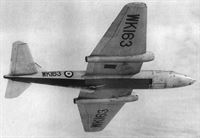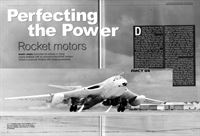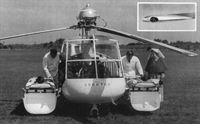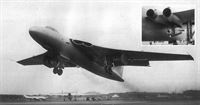Фотографии
-
de Havilland Sprite rocket engine. THE SPRITE was developed to assist Comet take-off in hot-and-high conditions. The vertical bridge in the mixing cup was a splash-plate to break down the catalyst into droplets and promote distribution with the peroxide fuel. This drawing first appeared in Flight of February 2, 1950.
Самолёты на фотографии: De Havilland Comet / D.H.106 - Великобритания - 1949
-
Регистрационный номер: VP401 The Armstrong Siddeley Snarler rocket motor was installed in the rear fuselage of the prototype Hawker P.1040, redesignated P.1072. Liquid oxygen was fed from a forward fuselage tank through a ventral pipe, seen uncovered beneath the fuselage.
Самолёты на фотографии: Hawker Sea Hawk - Великобритания - 1947
-
Регистрационный номер: WK163 [2] The Scorpion was Napier’s first rocket motor for piloted aircraft, and was tested on Canberra B.2 WK163 which set a world altitude record of 70,310ft.
Самолёты на фотографии: English Electric / BAE Canberra - Великобритания - 1949
-
Регистрационный номер: WK163 [2] WK163’s Double Scorpion installation, showing its fuel tank.
Самолёты на фотографии: English Electric / BAE Canberra - Великобритания - 1949
-
Регистрационный номер: RA805 The Dovern testbed Lancaster 80001 early in 1951, before installation of the Type 3 Dovern. Note the cover over the pod air intake.
The Swedish STAL Dovern axial flow turbojet was installed in Lancaster I RA805, later given Swedish serial 80001. Because of the jet efflux, it was necessary for the twin tailwheels to be retractable.Самолёты на фотографии: Avro Lancaster / Type 683 - Великобритания - 1941
-
Регистрационный номер: FM209 This photograph of the Orenda test aircraft, FM209, was taken at Malton, Ontario, on September 16, 1950. The Lancaster was burnt out on March 23, 1955, and struck off charge by the RCAF on July 24, 1956.
RCAF Lancaster FM209 was a testbed for the 6,000lb-thrust Avro Orenda turbojet intended for the CF-100 fighter.Самолёты на фотографии: Avro Lancaster / Type 683 - Великобритания - 1941
-
Регистрационный номер: XA930 Самолет Victor B.Mk 1 с кодом XA930 использовался для испытаний штанги дозаправки топливом и подкрыльевых баков. В рамках этих испытаний он получил узлы для установки двух сбрасываемых ракетных ускорителей de Havilland Spectre, позволявших при взлете с массой 86 184 кг быстро набирать высоту. На фотографии запечатлен испытательный взлет с этими ускорителями, совершенный в Хатфилде 14 июля 1960 года.
Handley Page Victor XA930, in the only RATOG trial with de Havilland Spectre rockets, was airborne in 550yd at Hatfield.Самолёты на фотографии: Handley Page Victor / H.P.80 - Великобритания - 1952
-
Регистрационный номер: G-AMTZ Saunders-Roe Skeeter G-AMTZ was fitted with a Napier NRE.19 rocket boost system with propulsive nozzles in the rotor tips fed by a fuel tank above the rotor head. INSET The Skeeter’s rotor-tip rocket booster nozzle.
Самолёты на фотографии: Cierva/Saunders-Roe W.14 Skeeter - Великобритания - 1948
-
Регистрационный номер: WB215 Developed from the Sprite, de Havilland’s Super Sprite developed 4,200lb thrust at full power for 40sec and was tested on WB215, the second prototype Vickers Valiant, shown here at the 1956 SBAC Display, Farnborough. INSET A Super Sprite below and between the Valiant’s starboard engines.
Самолёты на фотографии: Vickers Valiant - Великобритания - 1951
-
Регистрационный номер: XD145 The mixed powerplant Saunders-Roe SR.53’s main motor was an 8,000lb thrust Spectre, shown here on XD145, the first of two prototypes.
Самолёты на фотографии: Saunders-Roe SR.53 - Великобритания - 1957
Статьи
- -
- Skywriters /Readers' letters/
- A.Welch - Veejay /Post-war civil/
- B.Jones - Perfecting the power /Airborne engine testbeds/
- D.Lang - All-Weather Mac /Masters of the air/ (2)
- F.Mormillo - Emergency 911 /Cover story/
- M.Oakey, T.Harmsworth - News
- M.Vines - ...Rare Aircraft Show /Show report/
- M.Vines - Photo Masterclass /Aviation photography/ (4)
- M.Vines - Spirit of Fairford /B-2 at RIAT '99/
- P.Franzini - A Late Renaissance /Italy's warbird scene/ (1)
- R.Nesbit - Hunter's Moon /Anti-submarine warfare/ (2)
- R.Paver - "No longer an island" /Re-enacting an epic flight/
- S.McKay - Ben Cooper /Obituary/
- T.Harmsworth - Echoes of the Battle of Britain /B of B film 30th/
- T.Harmsworth - Over the Moon and under the 'Kosh /Oshkosh '99 report/









